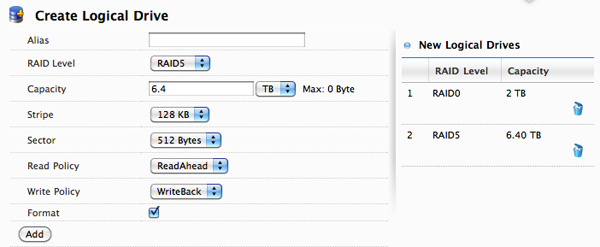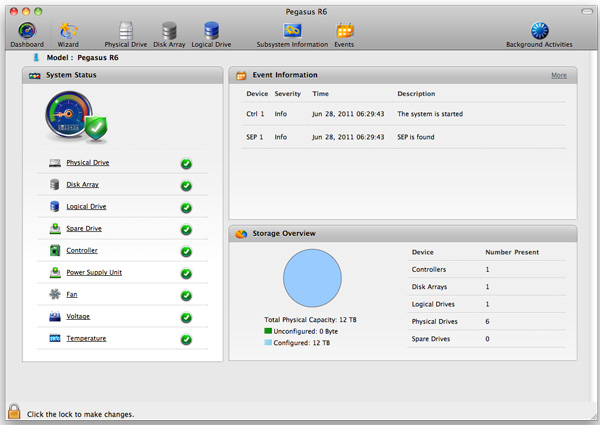Promise Pegasus R6 & Mac Thunderbolt Review
by Anand Lal Shimpi on July 8, 2011 2:01 AM ESTThe Pegasus: Software
The Pegasus ships fully functional from the factory, but you'll need to do a couple of things to your Mac before the first Thunderbolt device on the market will just work. First, the Pegasus (or any TB device) will only work on a 2011 MacBook Pro or 2011 iMac as those are the only two systems on the market today with an integrated Thunderbolt controller. Apple is widely expected to introduce a new Mac Pro and maybe even a new MacBook Air with Thunderbolt support, but for now you need a 2011 MBP or iMac.
![]()
If you have one of those two systems you'll need two software updates. The first is the Mac Thunderbolt Firmware Update and the second is Mac OS X 10.6.8 (or later, Lion is supported). With both software updates installed, simply plug in a Thunderbolt cable and you'll be greeted with a Promise RAID icon on your desktop.
The bundled Promise Utility gives you full control over the Pegasus including reporting on drive/array health:
The major functions of the Promise Utility are pretty self explanatory. The Dashboard is the home screen of the application, it gives you a quick look at the current status of your drives/arrays (e.g. green for good, yellow for caution, red for major issue):
By default the Pegasus ships in a RAID-5 configuration with either 4 or 6 drives depending on whether you bought an R4 or R6 model. The RAID-5 array is configured with a 128KB stripe size and 512-byte sector size. This generally offers the best balance of redundancy and performance for most users, however if you'd like to delete it and start anew you can.
The wizard gives you one click array creation if you don't want to deal with adjusting things like stripe and sector sizes. There are varying levels of advanced array creation, or you can always go full manual.

You can choose any combination of drives in the Pegasus to be included in a disk array. From there you can partition the aforementioned disk array into any valid RAID array(s) you'd like. For example, you can choose to include all 6 drives in an array and from there create a 2TB RAID-0 and use the remaining space as a 6.4TB RAID-5. Alternatively, you can use five drives in an array and use one as a hot spare. Finally you can choose to only use some of the drives in an array and leave the remaining drives in pass-through mode, accessible outside of any RAID arrays.
Any drives you don't include in the drive array can be set as spares.
The table below shows you the options you have when creating a custom drive array on the Pegasus (I've highlighted the defaults):
| Promise Pegasus Array Creation Options | ||||
| Item | Options | |||
| RAID Level | RAID0, RAID1E, RAID5, RAID6, RAID10, RAID50 | |||
| Stripe | 64KB, 128KB, 256KB, 512KB, 1MB | |||
| Sector | 512 Bytes, 1KB, 2KB, 4KB | |||
| Read Policy | ReadCache, ReadAhead, No Cache | |||
| Write Policy | WriteThru, WriteBack | |||
All major configuration changes require that you type the word "confirm" before proceeding, a nice way to ensure you don't accidentally delete something.

The Promise Utility reports on both array and drive level events. It'll tell you basic things like whether or not your current array is healthy or down a drive. At the drive level you do get basic SMART reporting including temperature and health status. You also have the option of dumping an advanced SMART log to a text file which includes the drive vendor specific SMART attributes and their current, worst and threshold values:

In the utility's physical drive list you can locate any drive in the Pegasus array. Hitting the locate button will cause the corresponding identify LED to blink on the Pegasus.
Like any other array under OS X, you do have to manually eject any volumes before unplugging the Thunderbolt cable or powering down the Pegasus. Failing to do so will give you this all-too-familiar error:



















88 Comments
View All Comments
etamin - Sunday, July 10, 2011 - link
hmm, I think I'm missing something here. Are you saying that the new MBPs have 12 lanes to the dGPU because 4 have been borrowed (on demand?) by the TB controller? or does the PCH has its PCI lanes? if so, how many? Thanks for the reply.repoman27 - Sunday, July 10, 2011 - link
Anand explained it in his review of the mid 2011 iMac, here: http://www.anandtech.com/show/4340/27inch-apple-im...etamin - Monday, July 11, 2011 - link
I see...I never noticed the PCH/SB always had PCI lanes of its ownrepoman27 - Saturday, July 9, 2011 - link
"At the end of a Thunderbolt chain you can insert a miniDP display, currently the only option is the 27-inch LED Cinema Display but in theory other panels that accept a miniDP input could work as well."Any DisplayPort enabled display will work, and there's plenty of those. You just need to use an asymmetrical cable. Just like you don't need a display with a mini/micro HDMI port to use the mini/micro HDMI out on the devices that have those. Or a PC with mini/micro USB ports.
mAxius - Sunday, July 10, 2011 - link
intel and apple will have thunderbolt the rest of the planet will have external pci express and usb who will winhttp://www.eetimes.com/electronics-news/4217190/PC...
Focher - Sunday, July 10, 2011 - link
According to that article, their standard is due for mid 2013. It's slower than TB and it's not even real. They've just announced plans to make something.repoman27 - Sunday, July 10, 2011 - link
“I'm not entirely convinced that we're limited by Thunderbolt here either - it could very well be the Pegasus' internal controller that's limiting performance.”I’m pretty sure what you’ve gone and done here is bumped into the ceiling imposed by the CPUs in those Macs only supporting a PCIe maximum TLP payload size of 128 bytes. You achieved a little better than 80% of the total 10 Gbps bandwidth available on one Thunderbolt channel in actual data throughput, which is surprisingly good. Even though that bandwidth is exclusive of PCIe’s normal 8b/10b encoding overhead, there’s no getting around the additional overhead inherent to any packetized protocol. A Thunderbolt controller paired with a northbridge that supports 4096 byte payload sizes could theoretically achieve around 99% of the full 10 Gbps.
You’ve also shown that one device using a single Thunderbolt channel can use > 50% of the bandwidth of the 4 PCIe 2.0 lanes connected to the Thunderbolt controller. Thus if you connected one 4-drive SF-2281 Pegasus R6 RAID-0 to each of the Thunderbolt ports on the 2011 iMac, you still shouldn’t expect more than 12,833 Mbps combined throughput.
The Target Disk Mode results are disappointing, although you’re always limited to the speed of the slowest drive that you’re transferring to/from. You didn’t mention what the iMac was packing, but if it’s still just the 1 TB 7200 RPM Seagate that was in the model you reviewed earlier, that would be the limiting factor. Did you check to see what you could pull using FireWire Target Mode between the two?
“simply displaying an image at 60Hz on the 27-inch Cinema Display requires over 6.75Gbps of bandwidth (because of 8b/10b encoding)”
I’m guessing that the 8b/10b encoding overhead is once again not present in the 10 Gbps per channel Thunderbolt bandwidth figure, just as for PCIe packets. Otherwise Thunderbolt would not be able to fully support the DisplayPort 1.1a spec which calls for 10.8 Gbps when including the 8b/10b padding.
“Apple claims that one of the channels is used for DisplayPort while the other is used for PCIe.”
This still flummoxes me. Does that mean that if you daisy chained 2 4-drive SF-2281 Pegasus R6’s to the Thunderbolt port on the MacBook Pro that you would achieve no better than 8021Mbps combined? That neither device could use the bandwidth of the second Thunderbolt channel even with no DisplayPort device present? Also, although Thunderbolt ports only support DisplayPort 1.1a resolutions, might they still support DP 1.2 features such as MST and daisy chainable displays? Or is the only way to connect multiple displays to one Thunderbolt port by using a DP 1.1a multi-display hub and thereby limiting the resolution of at least one of them to less than 2560x1440?
LedHed - Sunday, July 10, 2011 - link
By the time we have a decent amount of devices starting to use the Thunderbolt interface this will be outdated with the 2nd revision. Once again Apple is raising the price for no gain in anyway.LedHed - Sunday, July 10, 2011 - link
Also calling that huge array box mobile is hilarious in itself.xrror - Sunday, July 10, 2011 - link
So Apple will fix all the nagging issues with Thunderbolt connectivity when... they transition to ARM. Begone evil PC people, I'm sure Apple hates it thoroughly that iMacs and MBP can be "perverted" to x86's domain of Windows.So when MacOS basically is superseded by iOS for their "non-handheld mobile devices" and they finally eliminate iMac and MBP since "people who didn't transition to our new taint-ARM/Apple specific processor" line of devices are obviously just lame, as proven by the poor saps holding on to their PowerPC macs. Yea it's coming full circle.
Ugh... I really hope I'm just being paranoid/joking. But...